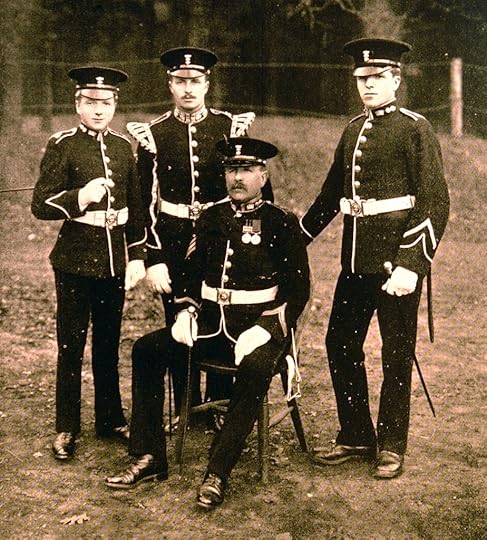The Evolution of the Regular and Service Battalions of Princess Victoria’s (Royal Irish Fusiliers) 1914-1918 – Part 2, The 1st Battalion
This essay describes the evolution of the 1st Battalion. The background to this essay may be found here.
1st Battalion

Pioneer Sergeant A L W Steele and his sons
When war broke out the 1st Battalion was stationed at Shorncliffe in Kent. The Army Reserve (those who had finished their period of regular service) had been mobilised by Royal Proclamation on 4 August 1914 and the men were ordered to report directly to the 1st Battalion or to the depot in Armagh.[1] The 1st Battalion was part of 10th Brigade, 4th Division, which had not deployed with the British Expeditionary Force in case of a German landing in Great Britain. It was dispatched in early August and the 1st Battalion landed in France on 23 August 1914.
The 1st Battalion subsequently suffered more casualties than any other battalion of the Regiment. It was sustained by drafts of Irish soldiers from the 3rd (Reserve) and 4th (Extra Reserve) Battalions until 1918. These were initially men of the Army Reserve and men of the Special Reserve—and some Cavalrymen transferred for infantry service—but increasingly from early 1915 the men who joined the 1st Battalion were wartime volunteers with a smattering of regular enlistments.
In August 1917 the 1st Battalion moved to 36th (Ulster) Division. The scale of the casualties suffered throughout late-1917 resulted in an influx of English soldiers to the Division and the 1st Battalion took its share, the first arriving in early 1918. These were men from the Army Service Corps and Army Ordnance Corps transferred for service as infantry, who joined in January and February 1918. Also in February 1918 the 1st Battalion absorbed 241 men from the disbanded 7th/8th (Service) Battalion, which included some men who had served previously in the 5th and 6th (Service) Battalions and in English regiments or in the support services.[2]
After the retreat from St Quentin in March 1918, which saw the near-destruction of the 1st Battalion, it received drafts of soldiers in early April from The London Regiment, most of whom were young conscripts new to France. It was this contingent of nearly 200 Londoners that fought at Wulverghem in April 1918, when the scale of the casualties reduced the Battalion to little more than a company and saw it attached to the 9th (North Irish Horse) Battalion.
The subsequent reconstitution of the 1st Battalion began with a draft of 32 men from The Prince of Wales’s Volunteers (South Lancashire Regiment), who joined on 1 May 1918, and a mixed batch of 75 men of The Hampshire Regiment and Prince Albert’s (Somerset Light Infantry). It also received a series of drafts totaling 229 men transferred from The Royal Irish Rifles and The Royal Inniskilling Fusiliers. Many of these men had previously been transferred from English regiments (including a draft of 65 men from The London Regiment transferred to the Royal Irish Rifles) but who had not been posted to their battalions before being reallocated to Princess Victoria’s (Royal Irish Fusiliers); a majority of them were recovered wounded and sick men who had seen previous service in France and Flanders.
Such was the make-up of the 1st Battalion until 22 September 1918 when a draft of 132 men joined; they had been transferred from The Royal Irish Rifles and were soldiers of various backgrounds, including men from English regiments and men from the Army Service Corps who had been transferred previously to The Royal Irish Rifles.
Details on each of these drafts may be found here: Princess Victoria’s (Royal Irish Fusiliers) 1914-1918 – Reinforcement Drafts
1. (Back) This and related proclamations may be seen on The Long Long Trail.
2. (Back) The War Diary of the 7th/8th (Service) Battalion records 240 men posted to the 1st Battalion. The War Diary of the 1st Battalion records receiving 241 men.



